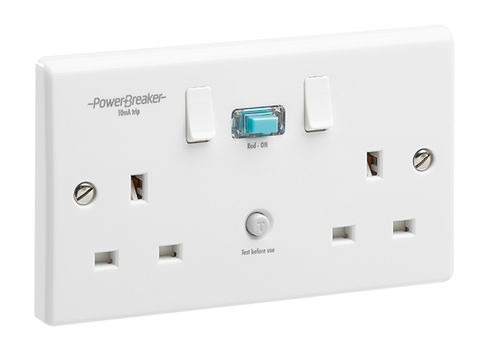Residual Current Devices (RCDs) have been commonplace in the UK since GreenBrook Electrical’s PowerBreaker was first launched over 40 years ago. While the core technology that started saving lives back then still does the same job today, RCD products have developed significantly since then.

Over the years, standards of safety, durability and aesthetics have all improved, driven partly by market forces and the need to stay ahead of the competition, and partly by revisions to BS and EN standards focused on driving improvements in safety and quality.
Despite the importance of the use of RCDs, research by Electrical Safety First (ESF) has provided some shocking statistics that highlight the fact that the UK is failing to exploit these simple and inexpensive devices to make every home safe. While ESF reports that 41% of all fire-related injuries are caused by electrical origin, over 40% of owner-occupied UK homes are not protected by RCDs. Those homes without RCDs are at risk of electrical injury, fatality or a house fire due to an electrical fault.
In addition, government figures estimates that 20% of electrical fires could be prevented by an RCD, highlighting the need for a greater take-up of electrical safety measures.
Of course, it is not only property that is at risk; just 250mA of current leaking through a human body for 200 milliseconds can be fatal. With their knowledge of just how quickly a small amount of electrical current can cause injury or death, electrical contractors should regularly suggest RCDs as cheap and effective protection for their domestic customers.
17th Edition updated
Over the years there have been many revisions to the legislation around RCDs and GreenBrook has continued to develop PowerBreaker products to meet and exceed all the latest standards. In the recent change to the 17th Edition, the standards around RCD protection were comprehensively updated with regard to the consumer unit. Previously, RCDs were not required on all sockets, so limited protection was provided. Now, the 17th Edition has brought to light the potential need for more RCDs in the home and workplace.
The latest changes now require RCDs to provide additional protection to all general use sockets rated up to 20A. This covers the majority of sockets in the home and office, making an improvement to safety. Additionally, protection must be provided in the event of a failure in basic protection or carelessness by the user.
All circuits now require 30mA protection, which can be achieved by a standard RCD in the consumer unit. The legislation also indicates that additional, not previously specified, areas now require RCD protection. The 17th Edition now states that as well as all consumer units, bathrooms within zones 1 and 2 should also include a RCD.
This change to legislation highlights how seriously the industry is taking RCD protection. As well as having strict compliance to the latest BS standards, which ensure that every RCD meets exacting quality criteria, the industry is now bringing RCDs to the forefront of home and commercial protection.
Meeting the legislation
There are lots of different ways to meet the new legislations. Generally, the most common way to protect the home is through the consumer unit, which can be configured to comply with the regulations. One example is to install a main switch with RCBOs protecting each individual circuit. Another suggestion is to opt for a main switch with two RCDs protecting split circuits.
Although the simplest method, there will be times when updating a consumer unit in this way may cause inconvenience to the end user. Often, the consumer unit in the house or office isn’t in the most accessible place to reset after a trip. If an individual 10mA RCD is placed locally and at low level, this should trip before a leakage build up is detected in the consumer unit and lower the risk of a fatal electric shock.
To keep up with growing trends and customer needs, GreenBrook’s PowerBreaker team has developed a new generation of 10mA RCDs alongside the range of standard 30mA sockets and spurs.
Although not a legal requirement, 10mA RCDs are becoming more commonplace as specifiers realise the benefits of these products in places such as hospitals and schools that need to ensure the highest level of protection. This is a growing trend in the market and it should be expected that more installations will be prone to this type of RCD going forward.
A thought to keep in mind when comparing RCD protection is that if an RCD is rated at 10mA, it is likely to be designed to trip below 10mA to ensure it complies with the rating on the box.
The use of 30mA RCDs in the UK is already widespread and is set to increase, along with the 10mA version as installations are refurbished and designed to comply with the 17th Edition of the Wiring Regulations. Having foreseen these trends, GreenBrook has developed new generation technology to secure its position as a leading UK supplier of RCDs. GreenBrook is constantly looking to improve and add to its comprehensive RCD range and the development of the 10mA RCD maintains GreenBrook at the forefront of the market.
